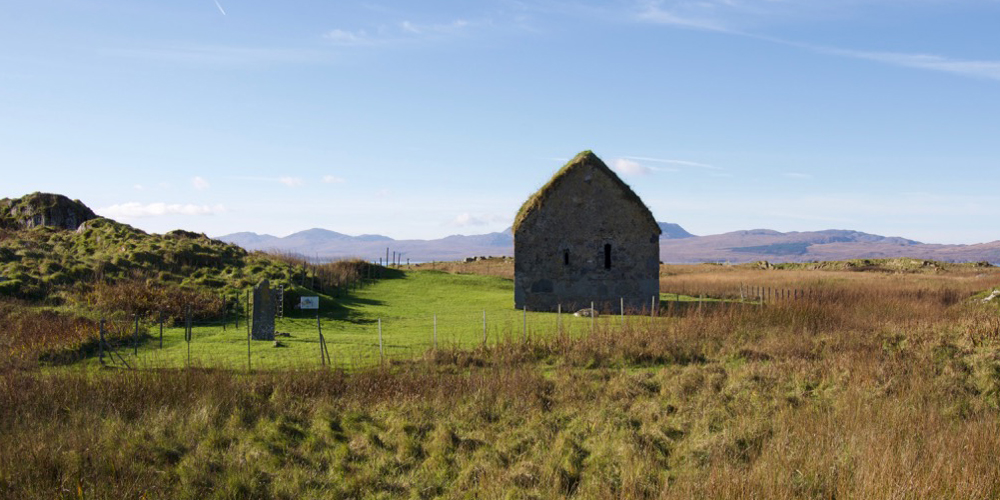
The secrets of St Cormac
Under a clear blue sky, with only the lightest breeze coming off the sea, I’m standing amid the mown grass of an old chapel enclosure and gazing at a carved stone.
I’m pretty sure I have enthused about a lot of carved stones in the past! Don’t ask me to count them! But none of them have been in a setting quite like this one. Eilean Mòr (‘big island’) in the MacCormaig Isles is tiny, despite its name, measuring just over half a mile in length; it’s also uninhabited, rocky and boggy in equal part, windswept and open to gales from every direction. It lies right out in the Sound of Jura off the coast of Knapdale, and to get there you have to go by charter boat (or take your own, if you have one!)
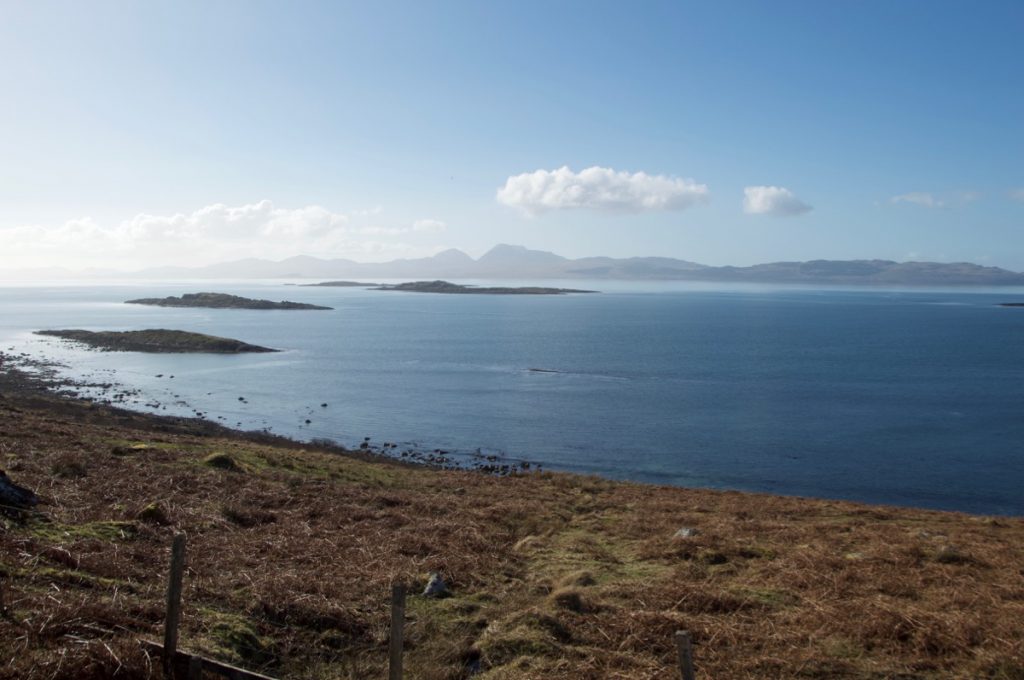 I’ve been dreaming about going to the MacCormaig Isles ever since I saw them from the road down to Kilmory Knap, many years ago. Silhouetted as slender black streaks in a silver sea, they looked unattainable, like places set adrift from time. Then I learned that (according to tradition) one of these islands was the chosen retreat of Cormac*, a rather elusive early Christian missionary-saint, and that it still had the remains of a chapel and a cross. I wondered which one it was, and painstakingly tried to enlarge my photos to see if I could see anything, to no avail.
I’ve been dreaming about going to the MacCormaig Isles ever since I saw them from the road down to Kilmory Knap, many years ago. Silhouetted as slender black streaks in a silver sea, they looked unattainable, like places set adrift from time. Then I learned that (according to tradition) one of these islands was the chosen retreat of Cormac*, a rather elusive early Christian missionary-saint, and that it still had the remains of a chapel and a cross. I wondered which one it was, and painstakingly tried to enlarge my photos to see if I could see anything, to no avail.
Now, finally, here I am on this secretive saint’s island, with geese calling from the shore a few hundred yards away, and wrens hopping in and out of the crevices in the rocks. I’m standing by the stone that’s said to mark his grave – a magnificent wheel-headed cross, now reduced to a broken shaft with just a few fragments of symbols and knotwork to hint at its former glory. I can’t help smiling at the sight of this stone and the chapel, its chancel still complete with turf roof. How ridiculously beautiful this place is.
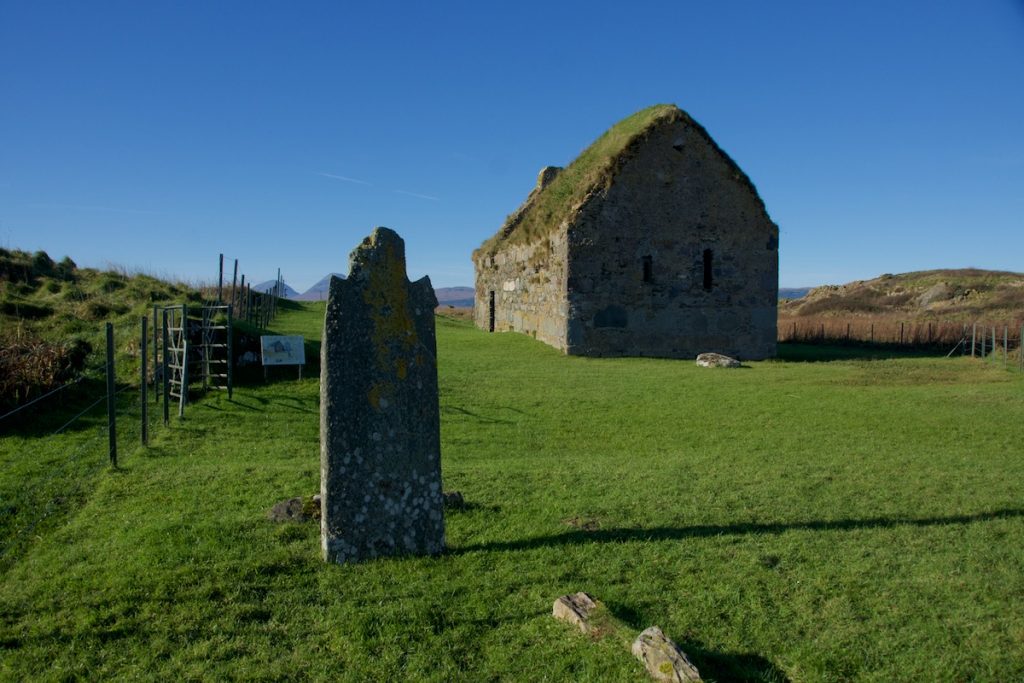
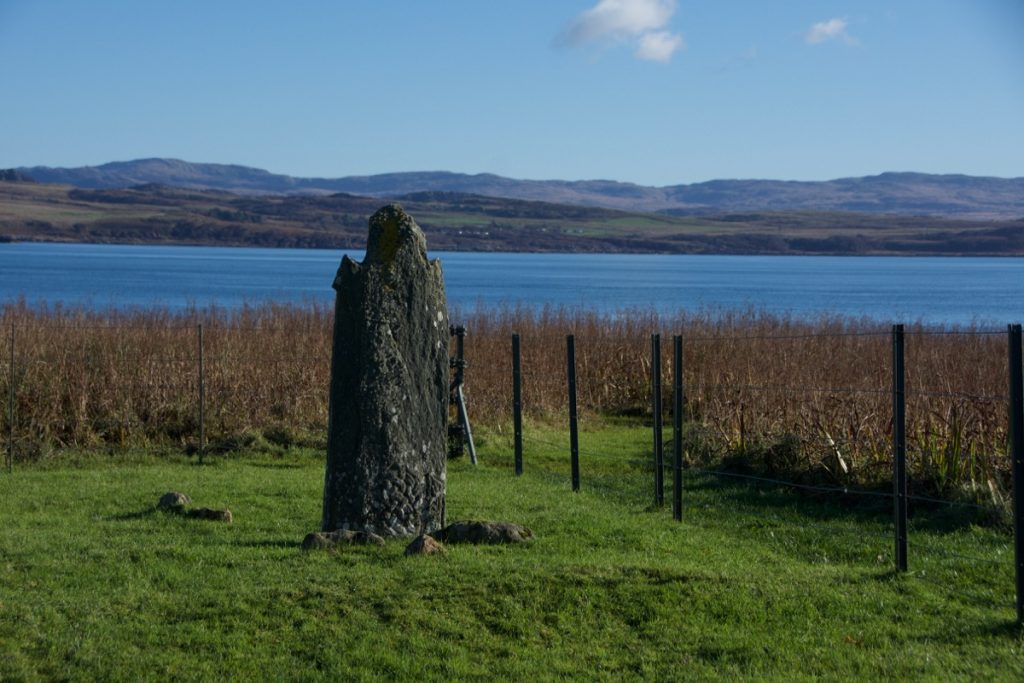 Who was St Cormac, and why did he come here? We know so little that the first question to answer is actually ‘which St Cormac?’, because there seem to have been more than one. Historic Environment Scotland tells us that the island “is traditionally associated with the Leinster saint Abbán moccu Cormaig, or St Cormag”, and of course there are multiple spellings of his name: Eibbán or Moabba, and also Charmaig, Corbmaic and Cormaic (he gave his name to the islands).
Who was St Cormac, and why did he come here? We know so little that the first question to answer is actually ‘which St Cormac?’, because there seem to have been more than one. Historic Environment Scotland tells us that the island “is traditionally associated with the Leinster saint Abbán moccu Cormaig, or St Cormag”, and of course there are multiple spellings of his name: Eibbán or Moabba, and also Charmaig, Corbmaic and Cormaic (he gave his name to the islands).
Abbán moccu Cormaig is believed to have been an Irish missionary-saint in the era of St Columba, around the 6th or 7th century AD. Churches in County Laois and Wexford are associated with him. He may have journeyed across the Irish Sea, because his name is thought to be connected with Keills Chapel, which stands just a couple of miles away from the MacCormaig Isles, on the mainland of Knapdale. We visited Keills a few years ago, and marvelled at its collection of grave slabs and 8th century cross.
St Cormac, having established a church at Keills, seems to have felt that he needed an occasional retreat that was even more remote than his chosen location, and settled on a cave on Eilean Mòr. There is no historical evidence to back this up: but in the 7th century, Historic Environment Scotland believes there was an ‘eremitic community’ here, suggesting a small monastic settlement similar, I would imagine, to that established by St Brendan in the Garvellachs. If there was a chapel built at that time, it has long since disappeared or been replaced by the present building, which dates from the 13th century. However, traces of an oval enclosure can apparently be made out on the ground around it, which is a strong clue for an early Christian church.
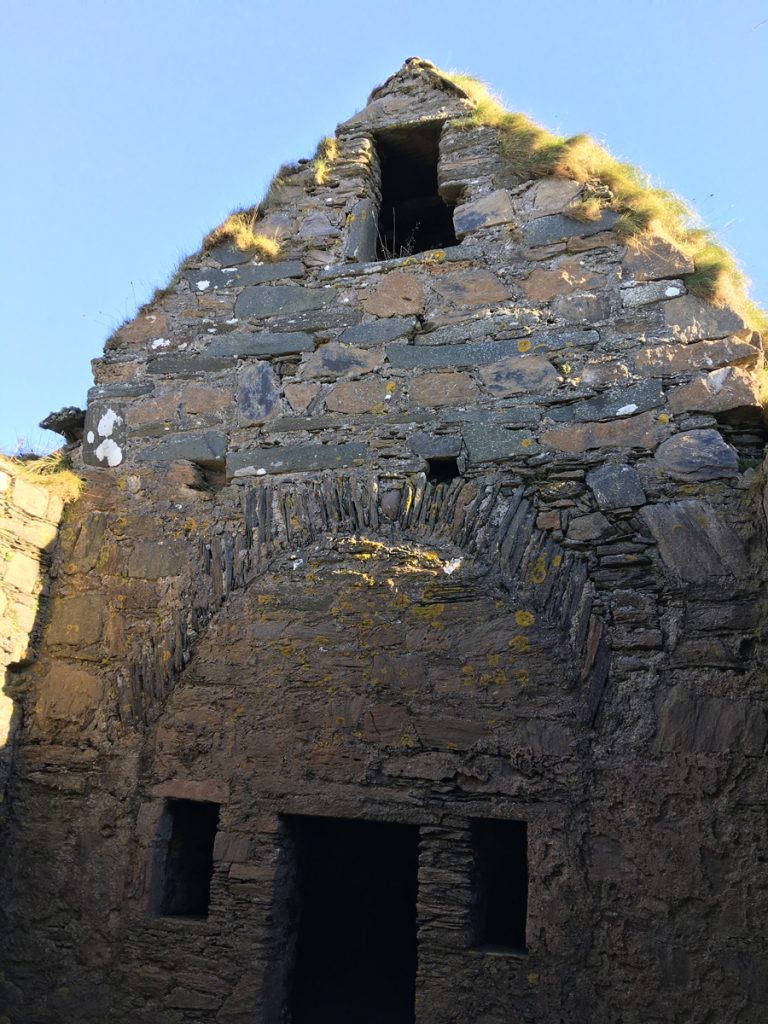 I stepped inside the chapel via the south-facing doorway which leads into the roofless nave. It seemed as if the building had been modified at least once in the past, with a large archway to the right having been built upon and incorporated into a higher wall, and the signs of what looked like a fireplace in the opposite gable wall. All a bit confusing. I turned to the right and entered the roofed part, which is the chancel. Immediate gloom and damp – the stone floor held puddles of water – and a reclining effigy dimly visible, lying over a tomb in the south wall. Above, a barrel vaulted ceiling gave a hint of grandeur, albeit on a small scale. I later learned that this feature was added by John, 1st Lord of the Isles, who repaired the chapel in the 14th century. Not entirely happy with the effigy over an open tomb in such a confined space, I probably didn’t give John MacDonald’s ceiling the attention it deserved, and was quite glad to get back outside.
I stepped inside the chapel via the south-facing doorway which leads into the roofless nave. It seemed as if the building had been modified at least once in the past, with a large archway to the right having been built upon and incorporated into a higher wall, and the signs of what looked like a fireplace in the opposite gable wall. All a bit confusing. I turned to the right and entered the roofed part, which is the chancel. Immediate gloom and damp – the stone floor held puddles of water – and a reclining effigy dimly visible, lying over a tomb in the south wall. Above, a barrel vaulted ceiling gave a hint of grandeur, albeit on a small scale. I later learned that this feature was added by John, 1st Lord of the Isles, who repaired the chapel in the 14th century. Not entirely happy with the effigy over an open tomb in such a confined space, I probably didn’t give John MacDonald’s ceiling the attention it deserved, and was quite glad to get back outside.
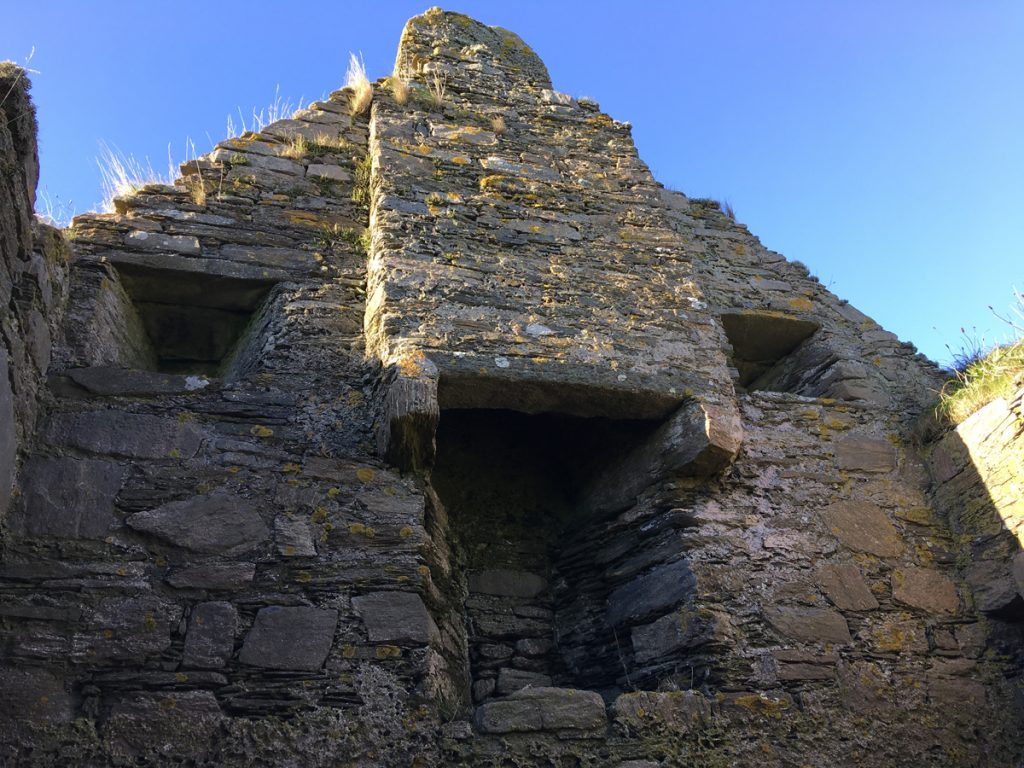 And the fireplace? Apparently, in the late 1600s or early 1700s, the building became a dwelling, possibly for a tacksman. Perhaps a second floor was added at that point, and there are apparently traces of agricultural buildings in the immediate vicinity. By the late 18th century, however, Eilean Mòr was abandoned and used only for grazing (the chapel made a convenient byre).
And the fireplace? Apparently, in the late 1600s or early 1700s, the building became a dwelling, possibly for a tacksman. Perhaps a second floor was added at that point, and there are apparently traces of agricultural buildings in the immediate vicinity. By the late 18th century, however, Eilean Mòr was abandoned and used only for grazing (the chapel made a convenient byre).
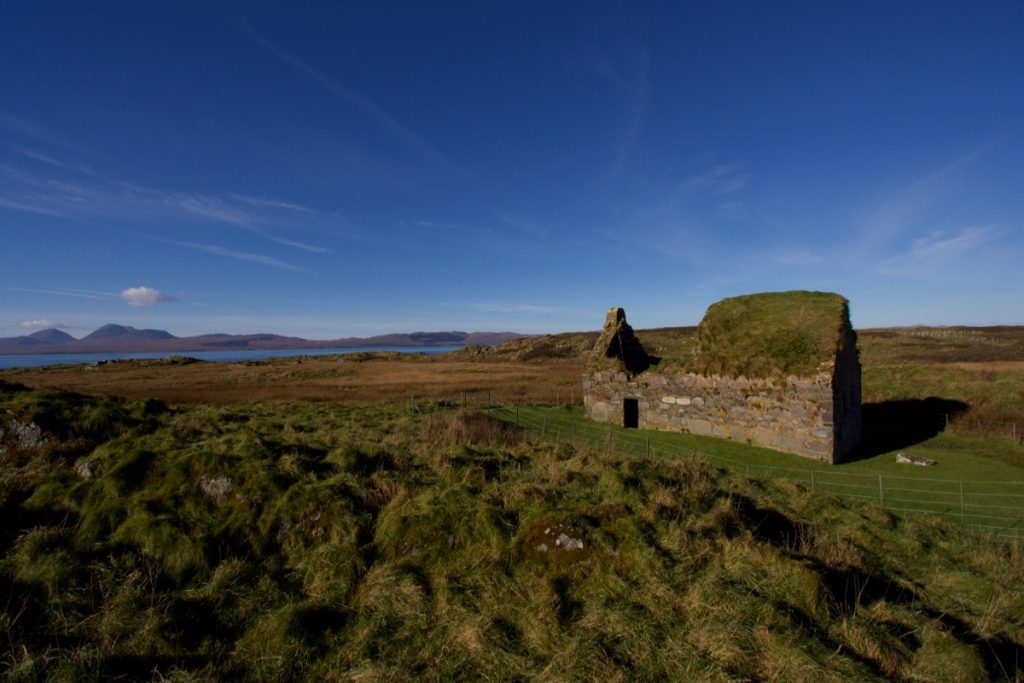 I walked right round the outside of the chapel, wading at one stage through standing water, examining the huge old stones and lime mortar that made up the walls, and the narrow windows. How lovely to see the roof with its thatch of turf – a feature I’ve not seen before on any of the chapels I’ve visited. Although I guess there must have been plenty of burials here, no other grave stones were visible in the graveyard; an interesting dished stone lies outside the east-facing wall.
I walked right round the outside of the chapel, wading at one stage through standing water, examining the huge old stones and lime mortar that made up the walls, and the narrow windows. How lovely to see the roof with its thatch of turf – a feature I’ve not seen before on any of the chapels I’ve visited. Although I guess there must have been plenty of burials here, no other grave stones were visible in the graveyard; an interesting dished stone lies outside the east-facing wall.
Back through the gate and along on the footpath that leads southwards through the rough grass, casting lingering glances back at the diminutive chapel against the vast panorama of sea and sky. On the highest point of the island is another cross, deliberately placed to be visible from afar. If you can drag your eyes away from the spectacular views, this one has an interesting history as well. According to Historic Environment Scotland, it was commissioned by Mariota de Ros, wife of Donald, 2nd Lord of the Isles, and John, “the island’s priest and hermit”. Interesting that the tradition of a resident hermit, begun in the 7th century, was being upheld 700 years later. The cross is very much in the tradition of that time, reminding me of similar crosses I’d seen in Ardchattan Priory (the MacDougall Cross) and Kilmory Knap (the MacMillan Cross). This one is, in fact, a replica – the original is in the National Museum of Scotland.
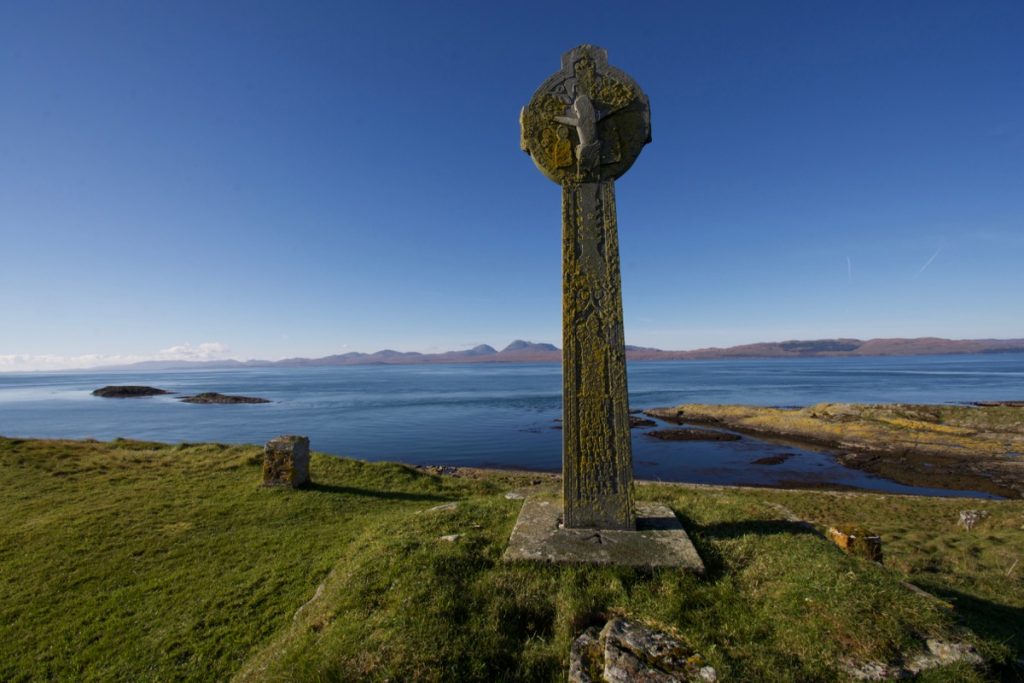
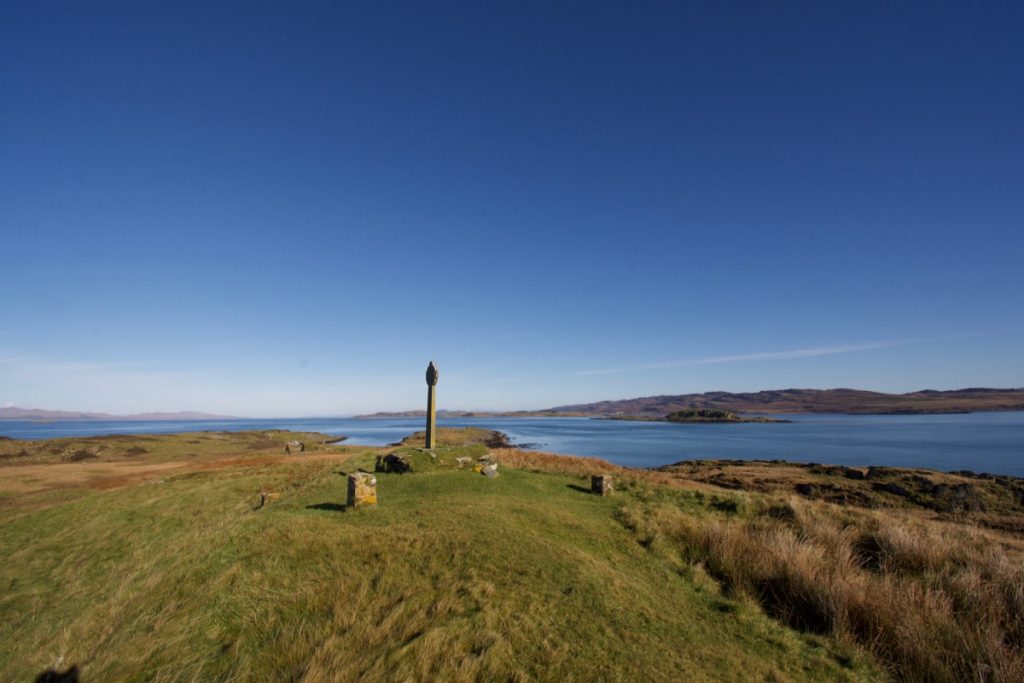
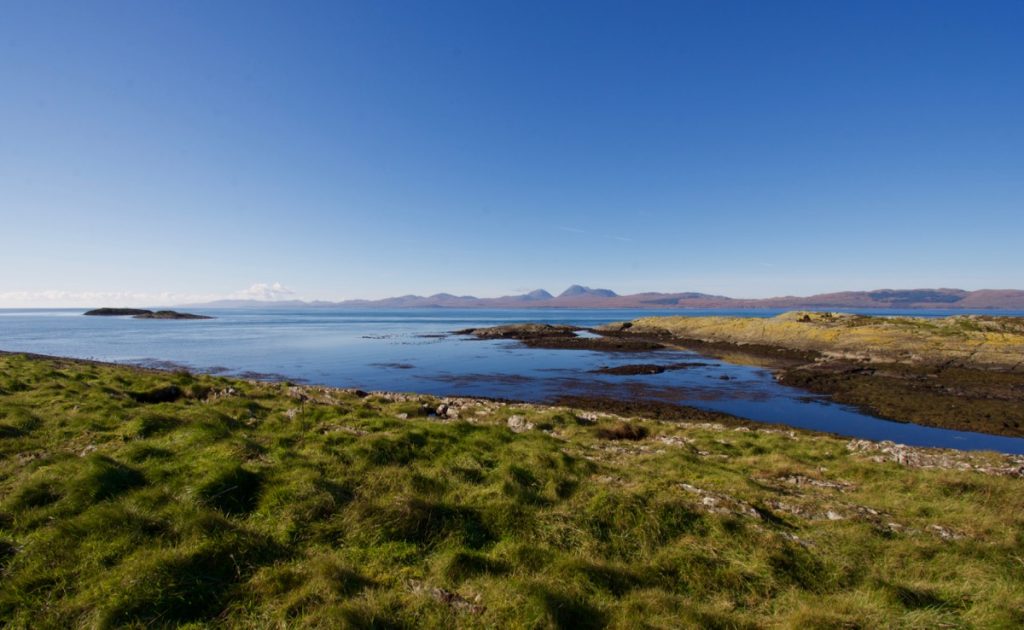 I was quite excited to see St Cormac’s Cave, and only slightly daunted by the steep bank that you have to navigate to get to it. Wellies aren’t the best at gripping the ground, so I slithered rather than climbed, while clinging on to handy protruding rocks. (By this time, it has to be said, Colin had roamed over almost all of the island’s surface area, and was overjoyed with sightings of snipe and otters. He met me on the way down, still excited about them). The path by this time was almost at shore level, and led round to the left, opening out into another grassy enclosure that was backed by some low cliffs. Somewhere in those cliffs, I realised, was the cave… and in between, wedged into a natural gap in the rocky outcrop, were the remains of a tiny stone building that you obviously had to pass through first. This, according to the information sign, is thought to have been a kind of shrine, perhaps to control the number of pilgrims who visited the cave in later centuries.
I was quite excited to see St Cormac’s Cave, and only slightly daunted by the steep bank that you have to navigate to get to it. Wellies aren’t the best at gripping the ground, so I slithered rather than climbed, while clinging on to handy protruding rocks. (By this time, it has to be said, Colin had roamed over almost all of the island’s surface area, and was overjoyed with sightings of snipe and otters. He met me on the way down, still excited about them). The path by this time was almost at shore level, and led round to the left, opening out into another grassy enclosure that was backed by some low cliffs. Somewhere in those cliffs, I realised, was the cave… and in between, wedged into a natural gap in the rocky outcrop, were the remains of a tiny stone building that you obviously had to pass through first. This, according to the information sign, is thought to have been a kind of shrine, perhaps to control the number of pilgrims who visited the cave in later centuries.
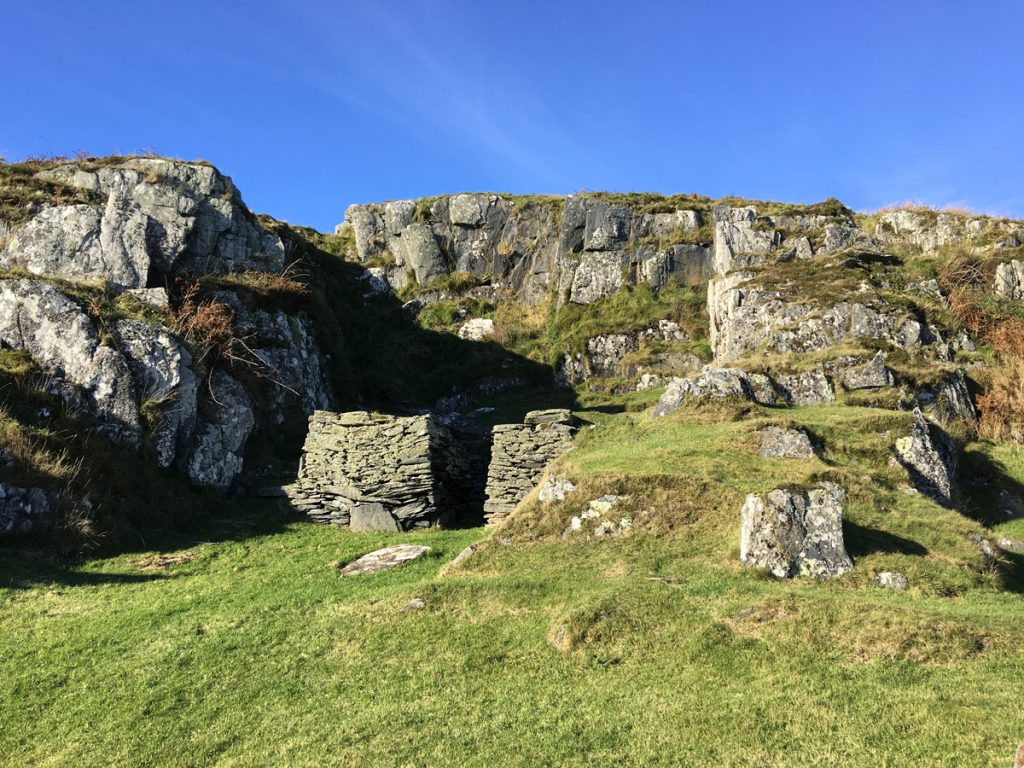 At one time, the cave was approached via a short tunnel leading out behind the shrine, but this has long since collapsed. One of the flat stones tipped up as I stepped on it, and I was suddenly reminded of Indiana Jones approaching the temple where the Holy Grail was guarded by the last Knight of the Crusades. (There’s actually a fascinating parallel here, and I’ll tell you more in a bit, if you’re prepared to suspend disbelief for a minute!)
At one time, the cave was approached via a short tunnel leading out behind the shrine, but this has long since collapsed. One of the flat stones tipped up as I stepped on it, and I was suddenly reminded of Indiana Jones approaching the temple where the Holy Grail was guarded by the last Knight of the Crusades. (There’s actually a fascinating parallel here, and I’ll tell you more in a bit, if you’re prepared to suspend disbelief for a minute!)
The cave itself turned out to be more of a pit, and a gloomy one at that. A natural cavern, I imagine, created by cooling basalt columns, its floor lies about eight feet below the opening, and can’t be much more than nine or ten feet at its widest. To one side of this chamber, I could see a very narrow vertical slit in the rock face with the suggestion of a further cave beyond, possibly only accessible by a thin hermit.
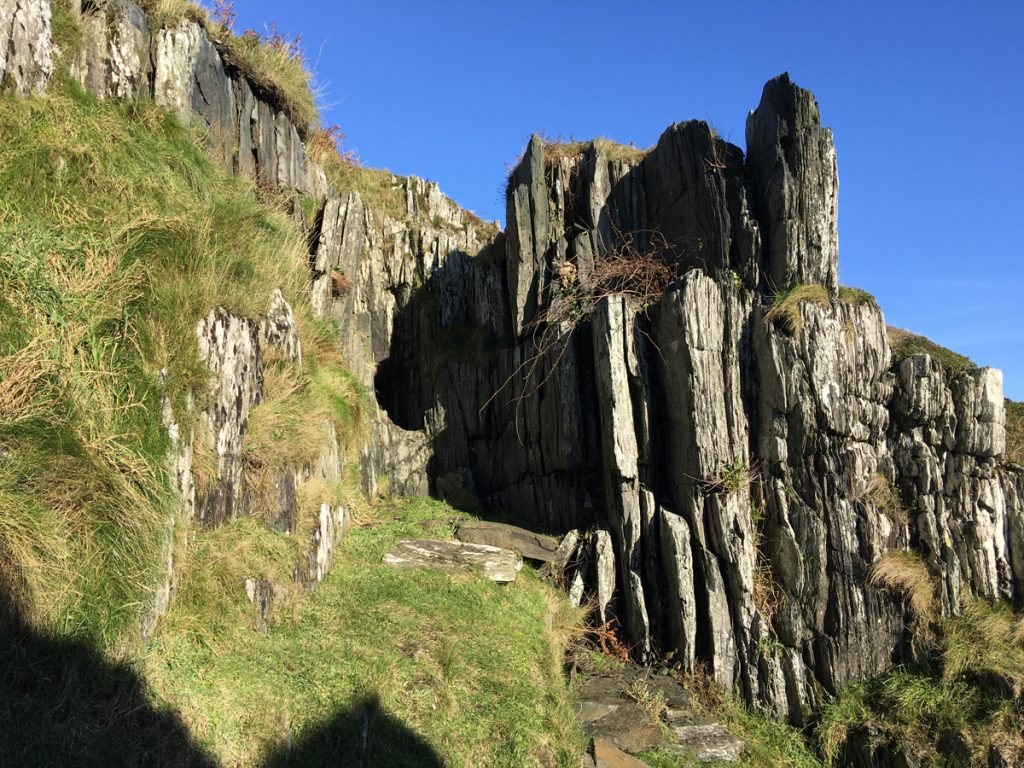
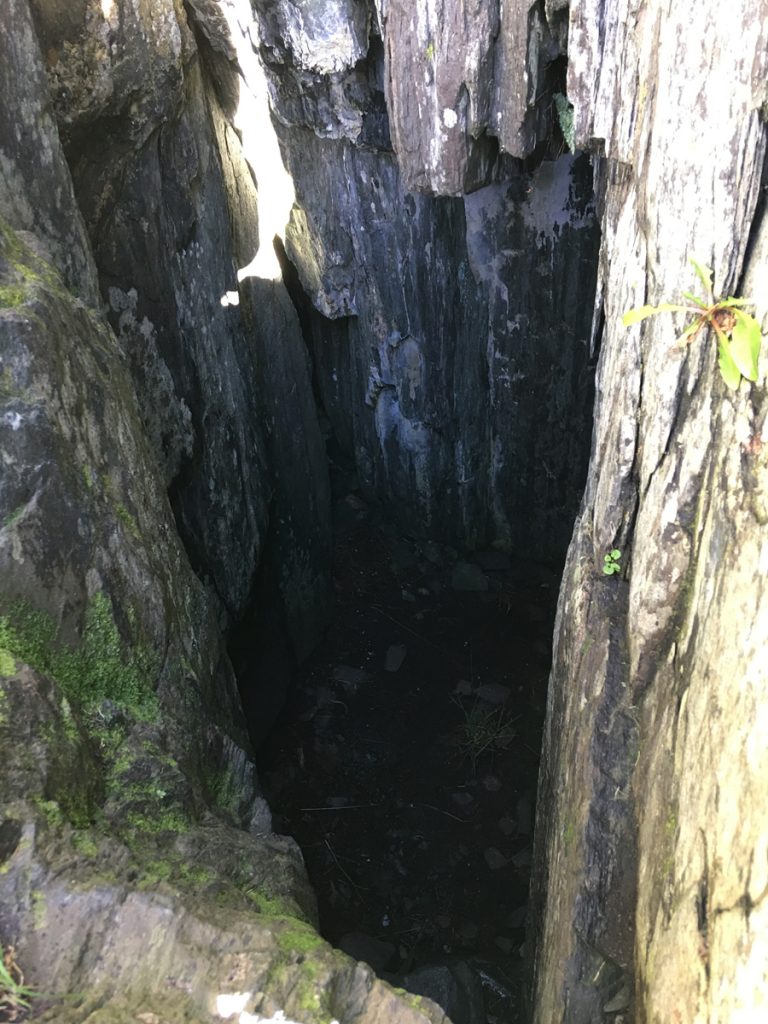 It certainly wasn’t the cosiest looking hide-out I’ve ever seen, and although I could have jumped down there fairly easily I had no wish to do so. In fact, I felt repelled by the place. My immediate thought was that it was the ultimate ‘man-cave’ – not surprisingly, because I knew about its history. Since then, having spent a few days reading more about it, I find that the Statistical Account of the Parish of South Knapdale (1797) claims that the cave “possesses the wonderful power of causing sterility in every person who dares to enter it.” Well, that’s one way of deterring unwanted visitors! And although I’m not planning on having any more children, I’m quite happy I didn’t climb in!
It certainly wasn’t the cosiest looking hide-out I’ve ever seen, and although I could have jumped down there fairly easily I had no wish to do so. In fact, I felt repelled by the place. My immediate thought was that it was the ultimate ‘man-cave’ – not surprisingly, because I knew about its history. Since then, having spent a few days reading more about it, I find that the Statistical Account of the Parish of South Knapdale (1797) claims that the cave “possesses the wonderful power of causing sterility in every person who dares to enter it.” Well, that’s one way of deterring unwanted visitors! And although I’m not planning on having any more children, I’m quite happy I didn’t climb in!
Just to add colour, the same record also describes the grave of St Cormac, in the graveyard of the chapel. It states that this tomb was covered, at one time, by an oblong building “elevated three feet above the ground” and warns that “the saint is said to resent, with the most summary vengeance, the least indignity offered to his monument.” Crikey. I’ve racked my brains but I don’t think I even stepped on it.
I did, however, return to the cave. I’d read on the information board that there were two early Christian crosses carved on one of the walls, and I wanted to see them. I was still adamant that neither of us should go in, so Colin helped me dangle over the side with my camera set on flash, aiming at what we thought was a circular symbol, glimpsed very much side-on. We managed, with limited success. I don’t really want to think about what St Cormac would have made of this, but I did apologise at the time.
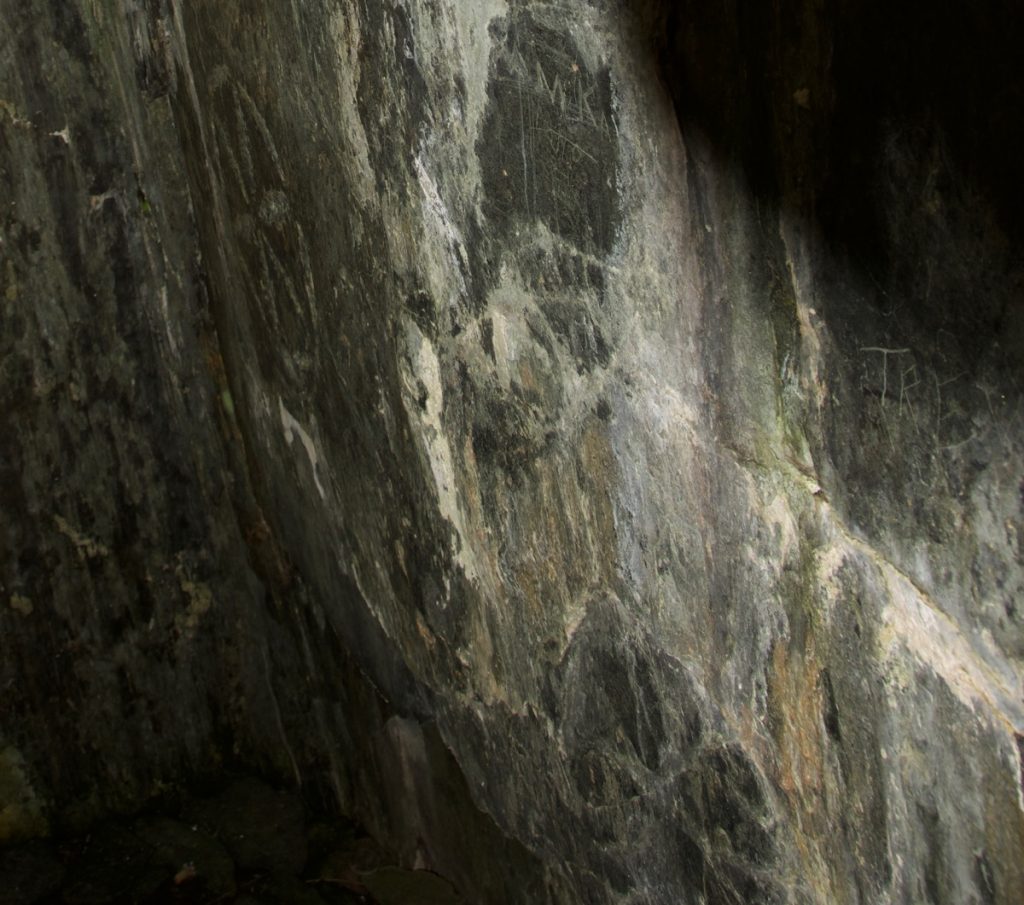 One cross is just visible top left, seen at an acute angle
One cross is just visible top left, seen at an acute angle
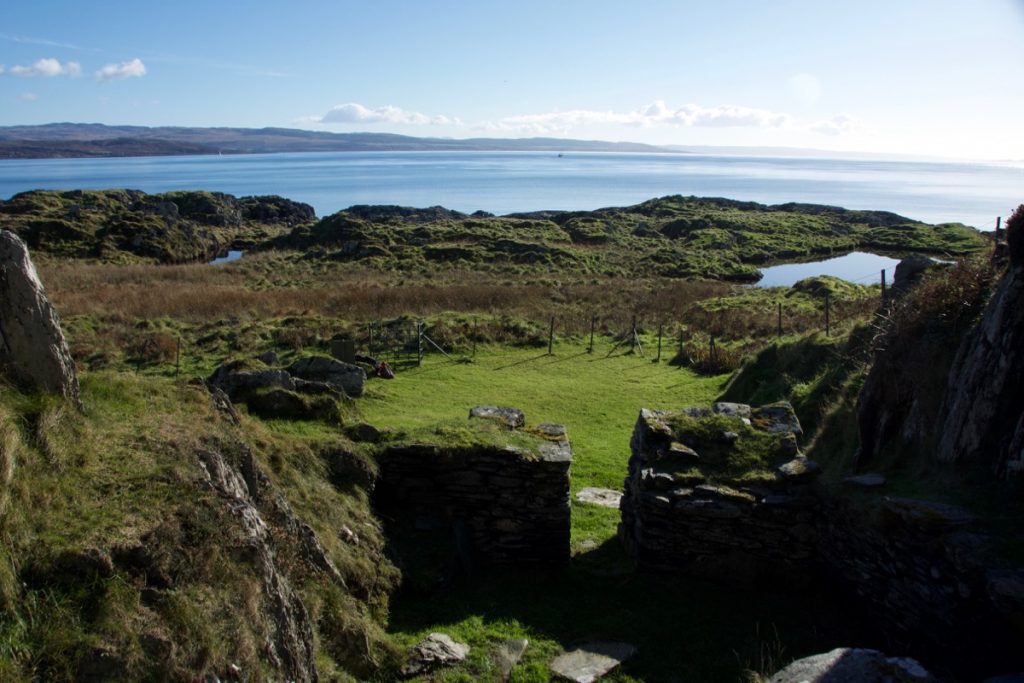 The view from above the ‘shrine’
The view from above the ‘shrine’
Two hours had just melted away, and it was time to start wending our way back. We clambered up the steep bank, stopping again to admire the cross and drink in the views; past the chapel and then down to the small jetty, where Farsain, the charter boat, was waiting. Her owner, Duncan Phillips, who had taken us down from Craobh Haven, had spent a while exploring the island as well, and was now waiting for us on board.
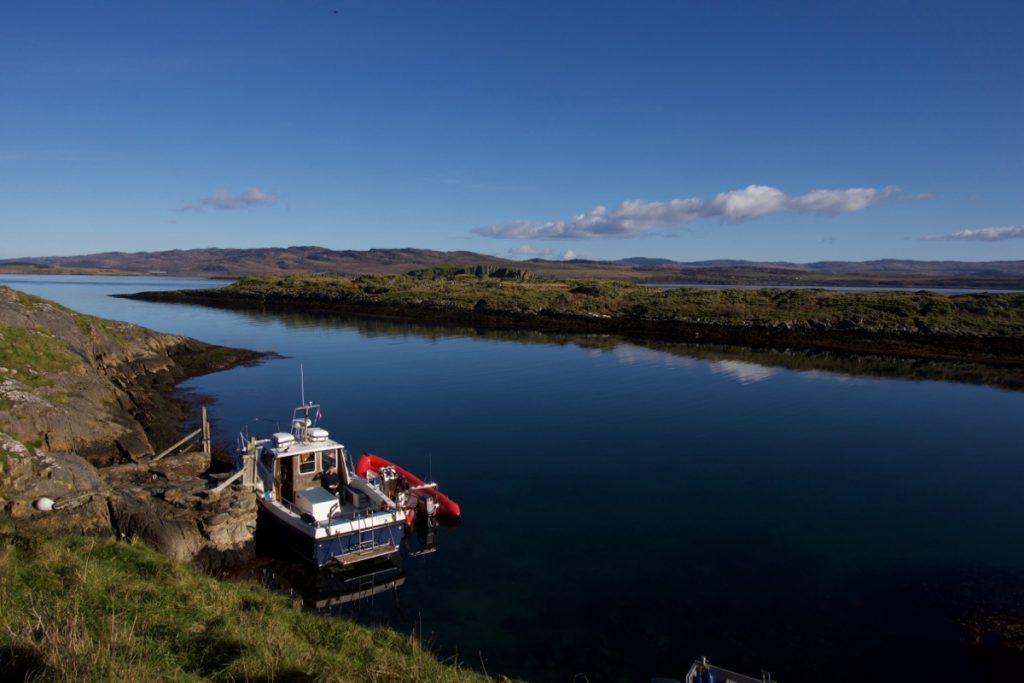
I couldn’t believe that the island has its own Visitor Centre – a recently renovated bothy, containing maps, reading material, information boards and small exhibits, as well as a lovely window display of items found on the beaches. You can add to the display if you like, and just bolt the door again when you leave.
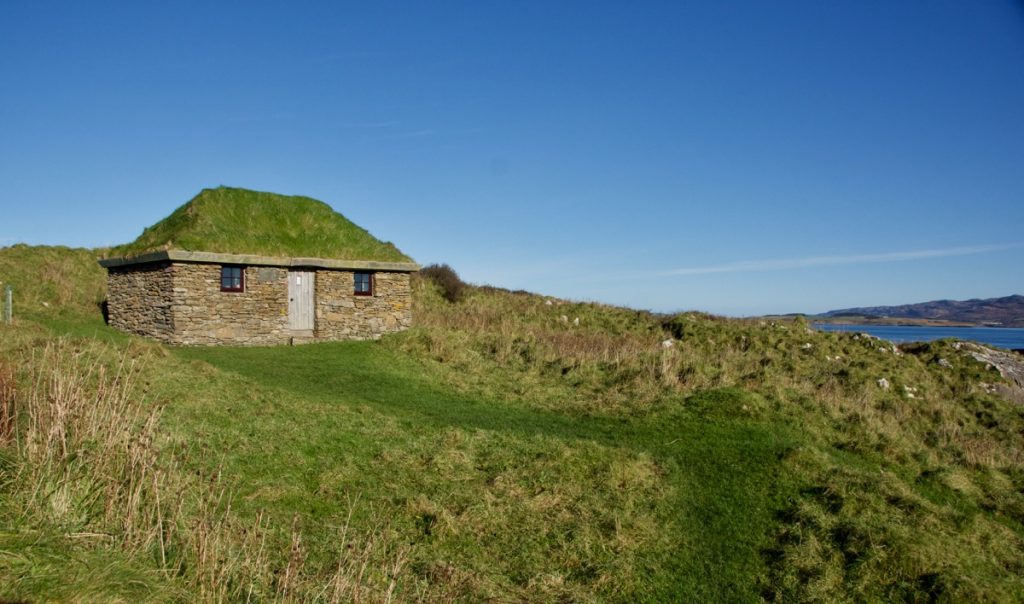
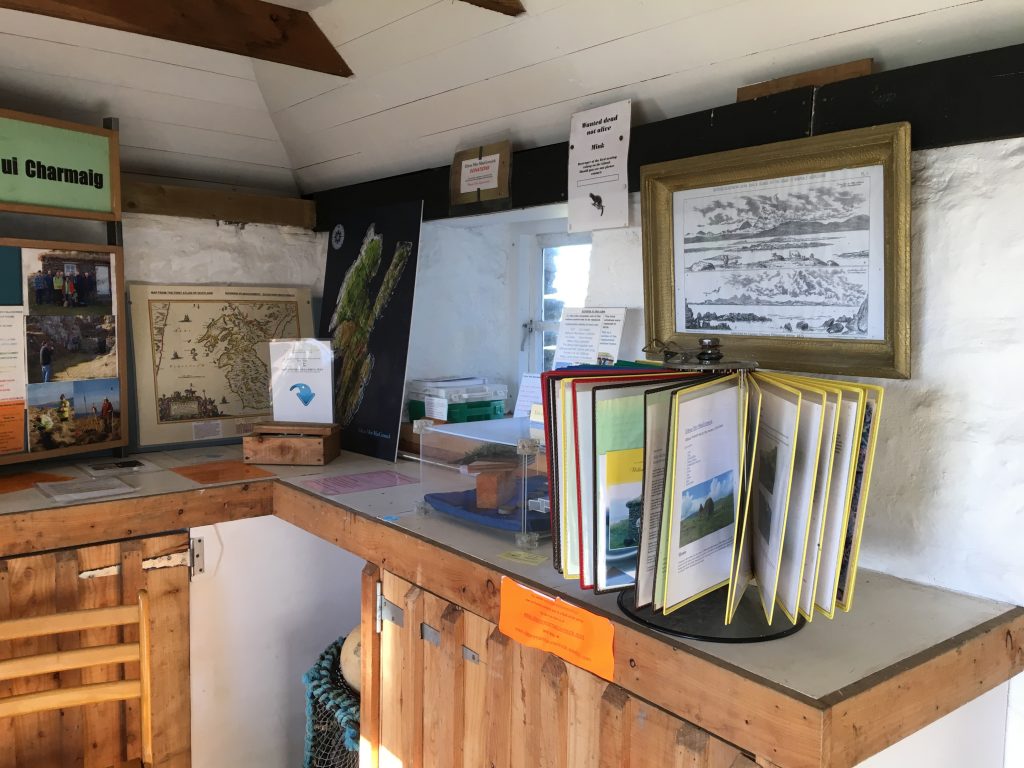
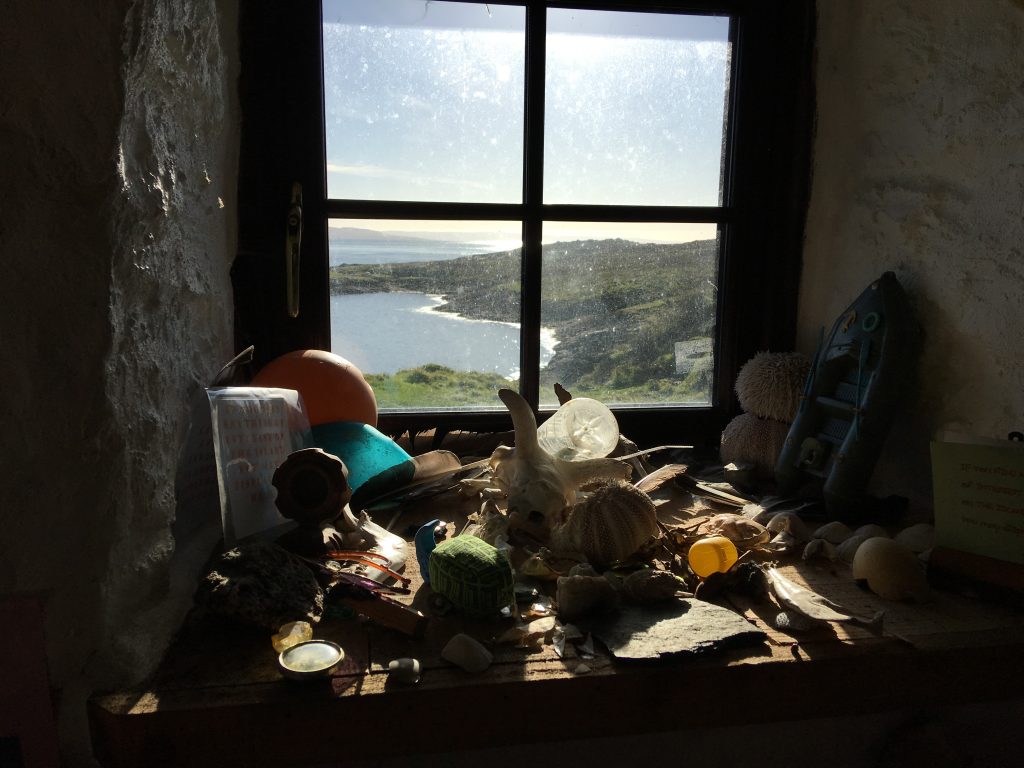 What a gorgeous, timeless place, dreaming away out there in the Sound of Jura with only otters and geese for company. It was with huge reluctance that I watched the McCormaig Isles dwindle and then merge into the blinding light of the sun, above the foaming wake of Farsain. I shall go there again often, in my imagination at least.
What a gorgeous, timeless place, dreaming away out there in the Sound of Jura with only otters and geese for company. It was with huge reluctance that I watched the McCormaig Isles dwindle and then merge into the blinding light of the sun, above the foaming wake of Farsain. I shall go there again often, in my imagination at least.
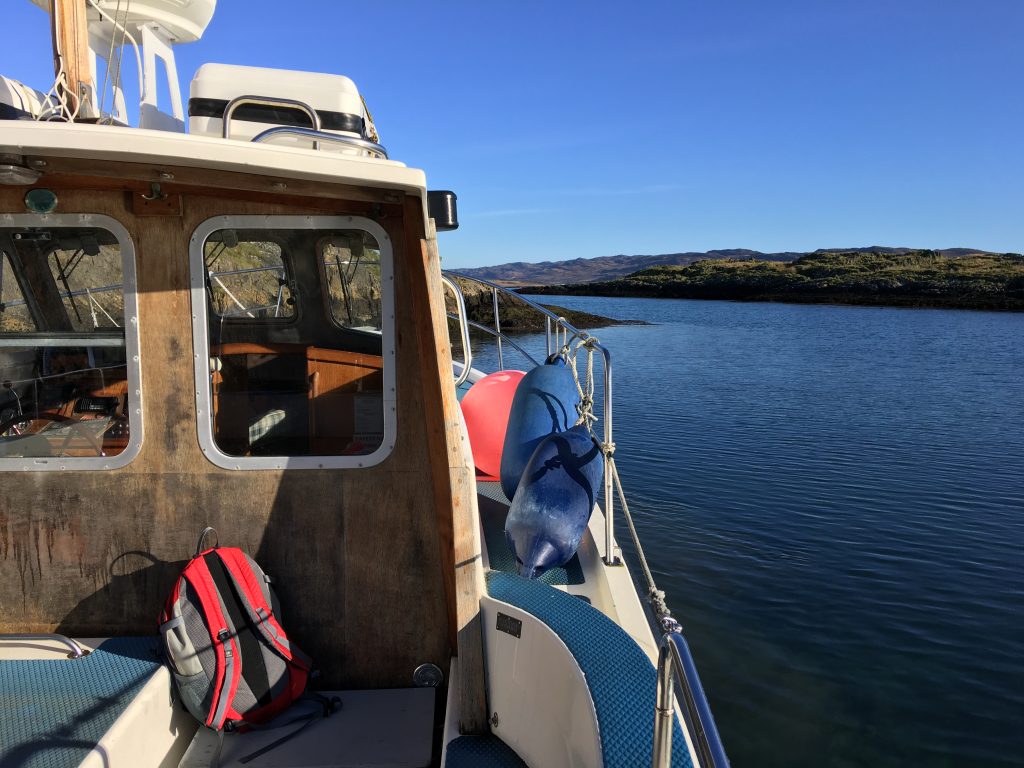
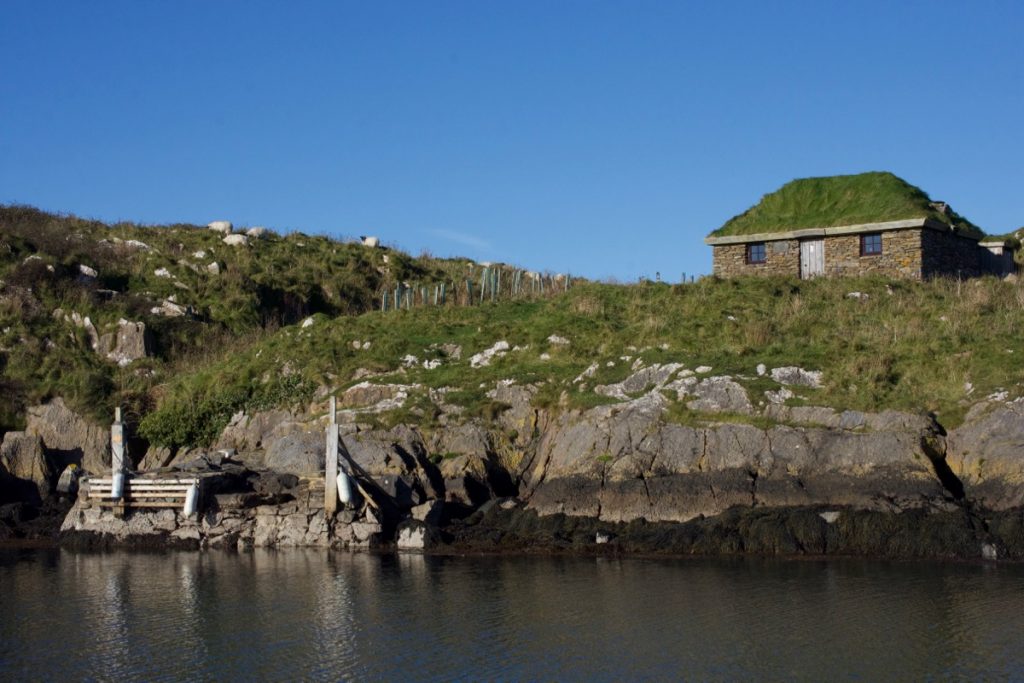
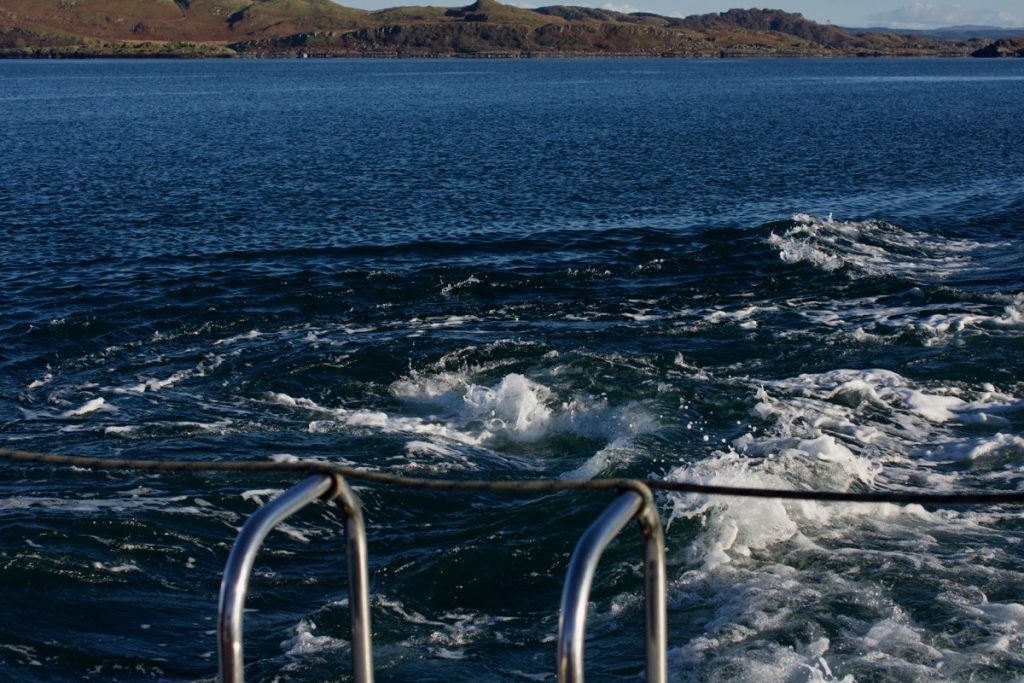 Duncan was a wonderful guide, pointing out places of interest and geological features on the coast. On the way back he piloted us through the Dorus Mor, a tide race associated with the Corryvreckan.
Duncan was a wonderful guide, pointing out places of interest and geological features on the coast. On the way back he piloted us through the Dorus Mor, a tide race associated with the Corryvreckan.
The mystery of St Cormac… and a delicious whiff of intrigue
‘The Statistical Account of the Parish of South Knapdale’ offers some intriguing stories, and I wanted to share them with you. The first one is ever so slightly weird:
“Near the west coast of Knap lie a group of small islands, the most considerable whereof is Ellanmore-kilvicoharmaig. Carmaig was an ancient proprietor of this island. His whole family consisted of a granddaughter, who used to amuse herself by angling on the shore, which is surrounded with currents, and frequented, to this day, by vast crowds of fish. It happened upon an occasion of this kind that a bone, in place of a fish, came out with her line; she unhooked, and threw it back in the sea. Again and again it came out in like manner. Chagrined with disappointment, she carried it home, and put it into the fire. The whiteness of its ashes struck her fancy. She endeavoured to preserve them; but, burning her finger in the attempt, instinctively clapt it into her mouth. By this means she became pregnant of the saint, whose supernatural gifts were so long to survive himself.”
So, hang on a minute, are you saying that Carmaig made his granddaughter pregnant? Meanwhile, the island itself seemed to have magnetic properties:
“Nothing could be stolen from [the island] that did not of itself return. The master of a vessel, conceiving a liking to the cross, carried it along with him, but being overtaken by a storm in the Mull of Cantire [Kintyre], was obliged to throw it overboard; it floated back to a creek of the island, called from that circumstance Portnacroish, i.e., the Harbour of the Cross.”
Statistical account of the Parish of South Knapdale, 1797, quoted in ‘Ecclesiological Notes on some of the Islands of Scotland’ by Thomas Scott Muir (1885).
And there’s more… you’ll remember I mentioned Indiana Jones? His quest for sacred artefacts has more than a faint echo in the legends of the Knights Templar, who (it has been argued) were the hereditary guardians of the Holy Grail.
I’ve written before about the story of the Knights Templar fleeing from France to escape the persecution of Pope Clement V and the French King, Philip IV, in the early 1300s. The order, whose humble origins lay in the role of guarding pilgrims in the Holy Land, had risen to great wealth and power – so much so, in fact, that fear of their capabilities seems to have been at the root of the Papal desire to stamp out their existence.
The Templars already had representatives and properties in England and Scotland, but it was to Scotland that (so it is said) the fleeing knights headed after 1307. Robert the Bruce, Scotland’s king, had been excommunicated by the Pope, and had nothing to lose in offering them sanctuary.
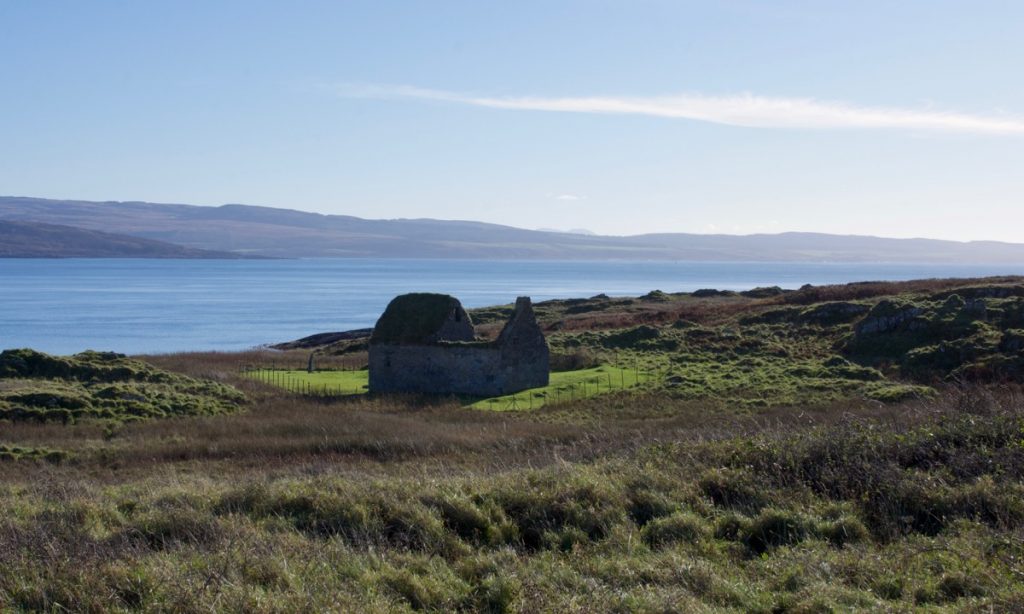 Sites around Argyll, including in particular Kilmory Knap Chapel, Kilmartin Glen and Loch Awe, are believed by some researchers to have links with the Templars. Grave stones etched with the outline of a sword are said to cover Templar graves, and their symbol of the cross pattée is visible on many stones in both Kilmartin and Kilmory. Historians would argue that this cross is simply an early Christian symbol, which of course it was. I’m just speculating, because I love the possibility.
Sites around Argyll, including in particular Kilmory Knap Chapel, Kilmartin Glen and Loch Awe, are believed by some researchers to have links with the Templars. Grave stones etched with the outline of a sword are said to cover Templar graves, and their symbol of the cross pattée is visible on many stones in both Kilmartin and Kilmory. Historians would argue that this cross is simply an early Christian symbol, which of course it was. I’m just speculating, because I love the possibility.
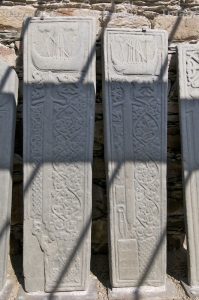
Now, a friend tells me about a local tradition, which says the Templars landed on Eilean Mòr and hid their treasure in St Cormac’s Cave. This delicious story is one I hadn’t heard before. Does this explain the crosses on the wall? They were a celibate order, which does kind of tie in with the sterility legend – and it might have been invented to keep raiders out. On the downside, it’s a comparatively small cave and wouldn’t hold ship-loads of treasure… but what did this treasure consist of, after all?
If the Templars did come here, it’s more than likely that they would have allied themselves with the Lords of the Isles. The MacCormaig Isles were within the lands of the Lordship, whose centre was at Finlaggan on Islay. Maybe Eilean Mòr held a special significance for them, hence the care with which the chapel was restored, and the erection of the magnificent cross.
We might never know for sure what happened, because the Templar story is so shrouded in mystery. I don’t mind that at all. But meanwhile I’ll do a little bit more research, and will let you know if anything interesting turns up.
Many thanks to Duncan Phillips of Farsain Cruises for a fabulous day out
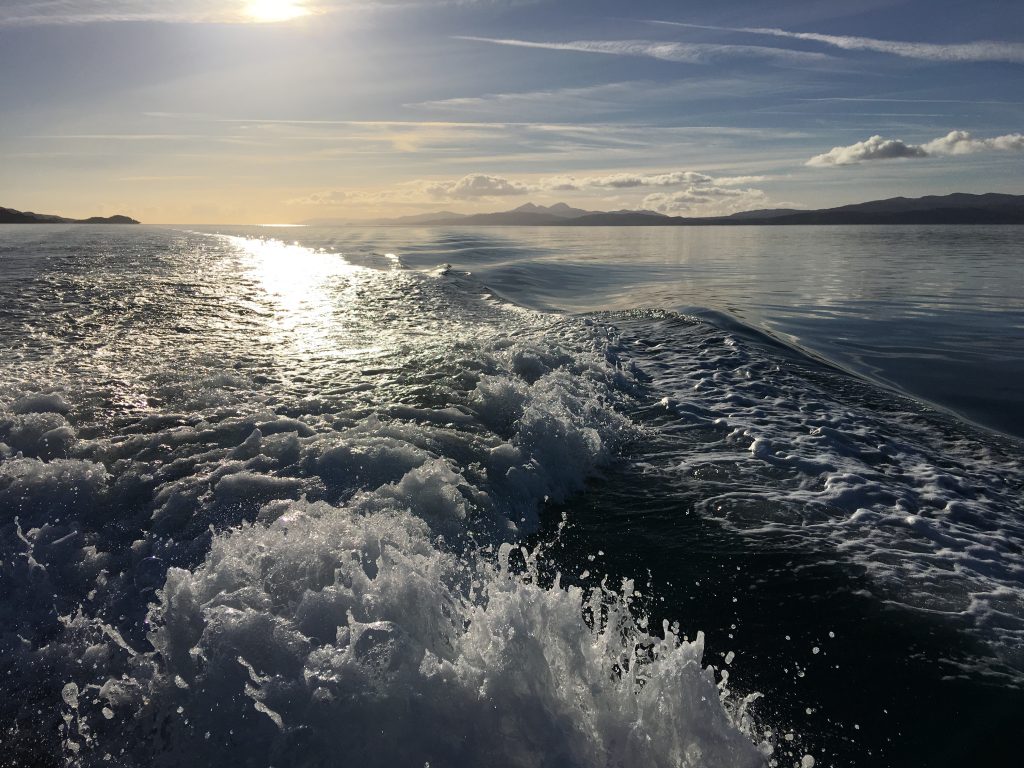
* I’m obliged to Gilbert Markus, Researcher in Celtic and Gaelic at the University of Glasgow, for the following comment via Facebook on 30th Nov, 2025:
Sources and further reading:
- Historic Environment Scotland
- Historic Environment Scotland: Eilean Mor – Statement of Significance (via above link)
- Canmore: St Cormac’s Chapel, St Cormac’s Cross and St Cormac’s Cave
- Saints in Scottish Place-names
- Catholic Online
- ‘Ecclesiological Notes on some of the Islands of Scotland’ by Thomas Scott Muir
- ‘In Search of the Knights Templar – A Guide to the Sites of Britain‘ by Simon Brighton
- ‘The Holy Blood and the Holy Grail’ by Michael Baigent, Richard Leigh and Henry Lincoln
- BBC Legacies: The Knights Templar in Scotland
Photos copyright © Jo & Colin Woolf

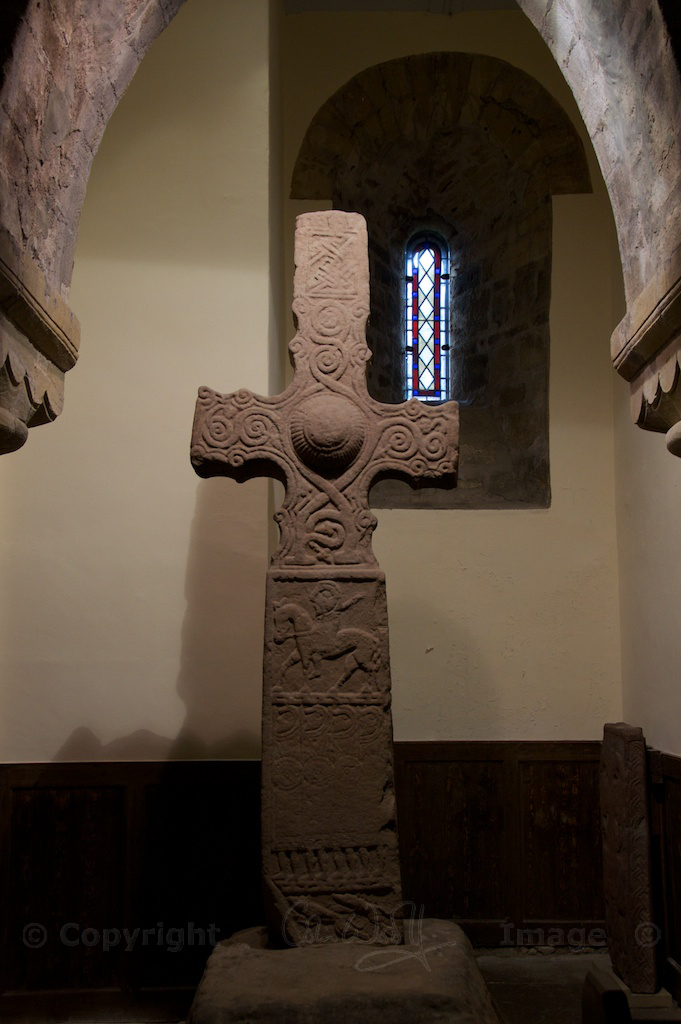
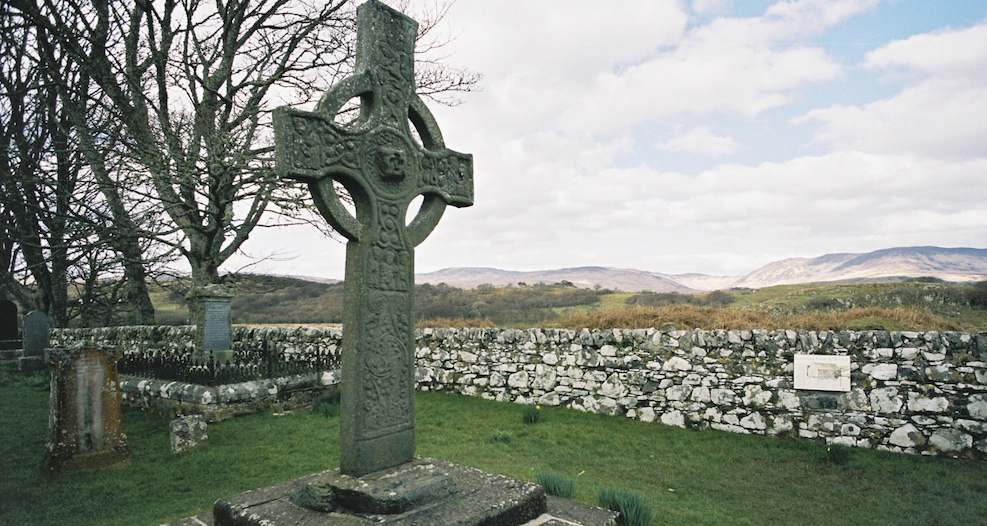
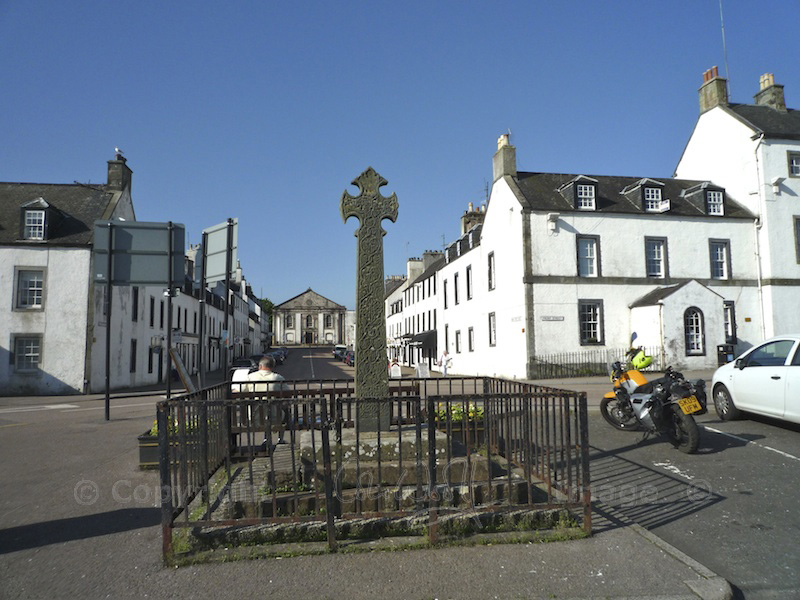
21 Comments
greg-in-washington
Amazing photos and story today! Enjoyed this very much.
Jo Woolf
Oh, thank you, Greg! 😀 I feel so lucky to have gone there!
Darlene
This is a lovely place. Thank you for the interesting commentary and stories!
Jo Woolf
Isn’t it amazing?! I’m glad you enjoyed reading about it. I hope I might find some more details – will keep you posted!
Deb Vallance
Thank you for this wonderfully evocative and intriguing post. Thoroughly enjoyed it!
Jo Woolf
Most welcome Deb, and I really enjoyed writing about it! Yes, such a fascinating story!
montucky
Fascinating! I appreciate the effort that went into this post!
Jo Woolf
Thank you! It was a real pleasure to read about it and re-live the visit! I think I might have to go back…
davidoakesimages
Always love your posts…they usually either remind me of places or demand I add them to that list that never gets shorter. OK this on goes on the list but right now I am feeling very envious/ no jealous . 🙂
Jo Woolf
Thank you, David! I’m glad the list isn’t getting shorter! 🙂 We enjoyed this day so much, and it’s got me thinking about other islands that may have forgotten stories.
davidoakesimages
You have my full permission to explore (now as winter approaches you can do some serious planning) 🙂
bconee
Thanks for sharing such a wonderful post! I really appreciate all the research you do to get as much information out to us readers. I love your photos too, they really make me feel like I’m there. 🙂 And what an intriguing story about the Templars!
Jo Woolf
That’s very kind, thank you! I really enjoy reading about these places, and I love the stories connected with them!
Finola
Really enjoyed this. Made me want to hop on that boat.
Jo Woolf
Thank you, Finola! It’s made us want to do some more island hopping too!
Moira Goodman
What a wonderfully interesting post Jo. Really want to go there as your description was so awesome and beautifully written as usual. Pictures so clear and the scenery just breathtaking. Keep these posts coming!!!!
Jo Woolf
Thank you very much, Moira! You can see what a beautiful place it is. So glad we finally managed to get there! I love the stories that these little places have. Nice to hear from you and I’ll certainly keep the posts coming!
Scott K Marshall
Well, this is just mind blowing and added to the bucket list – don’t take this the wrong way but your blog is – thee most amazing resource. And what a day to get to travel over too – photographically has such great potential sunsets – I assume little or no light pollution – what a milky way location.
Jo Woolf
I’m delighted that it’s a good resource, Scott, and there’s so much potential here for photography, daytime and night-time. The sunsets we had last summer were mind-blowing. You’re right that there’s little or no light pollution. We regularly see the Milky Way, and a hint of northern lights too. It’s fantastic. 🙂
Bob Hay
What a fantastic and enjoyable read Jo. Quite incredible that such undisturbed places still exist in isolation and yet so near busy Britain. The reference to the ‘cross’ making its way home reminds me of some of the old Saints’ Bells around the Highlands and Islands which always made their way home from wherever they’d been stolen.
With places like those you visit who needs doctors or medicines.
Incidentally did you ever come across or hear of an experiment carried out at Corryvreckan when they dropped some type of sonar devices into the main whirlpool and tracked them to their resurfacing many miles away? I can’t find it now.
Jo Woolf
Thank you, Bob! Yes, there’s such a timeless atmosphere in these places, as if they’re totally detached from the ‘real’ world. You can definitely feel the healing that is still there. I haven’t heard of the Corryvreckan experiment but if I come across anything I’ll let you know. There’s an island in Loch Shiel with an old chapel that still has its saint’s bell – would need some organising to get to it, but it’s something I’m thinking about!